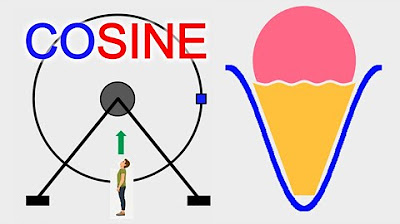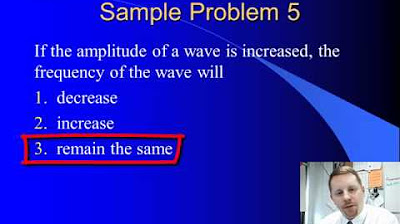The equation of a wave | Physics | Khan Academy
TLDRThe video script delves into the concept of wave equations, explaining their significance in describing the behavior of waves. It uses the analogy of a water wave to illustrate how the vertical height of a wave can be graphed against its position, creating a snapshot of the wave at a particular moment in time. The script then introduces the general form of a wave equation, highlighting the role of amplitude, wavelength, and the cosine function. It further explains the need for a time-dependent wave equation to account for the wave's movement, incorporating the period and phase shift to accurately describe a wave's position and height at any given moment. The explanation is clear, engaging, and mathematically sound, providing viewers with a solid understanding of wave equations.
Takeaways
- 🌊 A wave equation describes the shape of a wave as a function of position and time.
- 📈 The vertical height of a water wave can be graphed against its horizontal position to visualize its shape.
- 📊 The simplest wave form is a cosine wave, which can be represented by an equation with amplitude, wavelength, and position.
- 🌊🌀 The amplitude (A) represents the maximum height of the wave from the equilibrium level and is a key parameter in the wave equation.
- 📐 Wavelength (λ) is the distance over which the wave shape repeats and is represented by the Greek letter lambda in the equation.
- 📚 The general form of a wave equation is y = A*cos(2πx/λ), where y is the height, x is the position, and A and λ are constants.
- 🕒 To account for a wave's movement over time, the time variable (T) is incorporated into the equation with a phase shift.
- 🌟 The speed of a wave is related to its wavelength and frequency, and can be used to determine the period (T) of the wave.
- 🔄 The period is the time it takes for the wave to return to its original shape and position.
- 🔄 The wave equation can be modified to describe waves moving in different directions by changing the sign of the time-dependent phase shift.
- 📊 By plugging in specific values for position (x) and time (T), the wave equation can predict the height of the wave at any moment.
Q & A
What does the wave equation represent?
-The wave equation represents a mathematical formula that describes the vertical height of a wave as a function of position and time, providing a snapshot of the wave's shape at any given moment and its movement over time.
Why do we start with a simple wave to describe the wave equation?
-We start with a simple wave, such as a sine or cosine wave, because it is the mathematically simplest form of a wave to describe, making it a good starting point for understanding the basics of wave behavior and the wave equation.
How does the amplitude affect the wave equation?
-The amplitude in the wave equation dictates the maximum height of the wave from its equilibrium position. It is a measure of the wave's strength or intensity, limiting the vertical height to no greater than the amplitude value.
Why is the wave equation a function of both position (x) and time (T)?
-The wave equation is a function of both position (x) and time (T) because it aims to describe not only the shape of the wave at a single moment but also how this shape changes and moves over time, providing a comprehensive description of the wave's dynamics.
What role does the wavelength (λ) play in the wave equation?
-The wavelength (λ) indicates the distance it takes for the wave to complete one cycle and reset its shape. In the wave equation, it helps determine how the wave's shape repeats over space by specifying the distance over which the wave's profile repeats.
How does the wave speed factor into the wave equation?
-Wave speed is crucial for relating the spatial repetition (wavelength) and temporal repetition (period) of the wave. In the context of moving waves, knowing the wave speed allows for the calculation of the period (T), which is needed when the wave equation includes time dependence.
What is the significance of using cosine or sine functions in the wave equation?
-Cosine and sine functions are significant in the wave equation because they naturally model periodic phenomena, like waves, which repeat in space and time. The choice between cosine and sine depends on the wave's starting condition—cosine for a wave starting at a maximum and sine for one starting at zero or moving upwards.
Why might a phase shift be included in the wave equation?
-A phase shift might be included in the wave equation to model a wave that does not start at a typical starting point of a sine or cosine wave. It allows the equation to describe waves that are shifted in space or time, providing a more accurate representation of the wave's initial condition.
How do you determine the wave's period from its speed and wavelength?
-The wave's period can be determined from its speed and wavelength by dividing the wavelength by the speed. This relationship indicates the time it takes for the wave to complete one cycle and is essential for describing the wave's temporal behavior in the equation.
What does it mean when the wave equation includes a negative sign in the phase shift?
-Including a negative sign in the phase shift of the wave equation signifies that the wave is moving to the right. This directional information is crucial for accurately modeling the wave's movement in space over time.
Outlines
🌊 Introduction to Wave Equations
This paragraph introduces the concept of wave equations, explaining what it means for a wave to have an equation and how it can be represented mathematically. The narrator uses the example of a water wave to illustrate the vertical height of the wave as a function of its position, emphasizing the simplicity of the mathematical model despite real-world waves being more complex. The paragraph sets the stage for a deeper exploration of wave equations by discussing the importance of understanding the basic shapes and functions that describe waves.
📈 Applying the Wave Equation
This paragraph delves into the application of the wave equation, focusing on how to use it to describe the height of a wave at different positions. The narrator explains how the amplitude, wavelength (lambda), and the cosine function come together to form the equation. It also addresses the limitations of a static wave equation by highlighting the need for a dynamic model that accounts for the movement of the wave over time. The paragraph emphasizes the importance of testing the equation to ensure it accurately represents the wave's height at various positions.
🕒 Incorporating Time into the Wave Equation
The final paragraph discusses the incorporation of time into the wave equation to account for the wave's movement. The narrator introduces the concept of phase shift and period, explaining how they contribute to a wave's continuous motion. The paragraph also touches on the relationship between wave speed, wavelength, and period, and how this relationship can be used to find the period if the wave speed is known. The narrator then provides a comprehensive wave equation that takes into account both position and time, demonstrating its application by plugging in specific values for amplitude, wavelength, and period.
Mindmap
Keywords
💡Wave Equation
💡Amplitude
💡Wavelength
💡Cosine Function
💡Phase Shift
💡Period
💡Wave Speed
💡Sine Function
💡Equilibrium Level
💡Vertical Height
💡Harmonic Oscillators
Highlights
Explaining the concept of a wave equation and its significance in describing wave behavior.
Describing a water wave and graphing its vertical height as a function of position to visualize wave movement.
The importance of the amplitude in a wave equation, representing the maximum height of the wave.
The role of wavelength (lambda) in determining how far the wave resets in the x-direction.
The need for a wave equation to be a function of both position (x) and time (T) to accurately describe a moving wave.
Introducing the cosine function to model the wave's shape, starting at a maximum value.
The process of adjusting the wave equation to account for a wave's movement over time.
Using the speed of the wave and its wavelength to calculate the period of the wave.
The final wave equation that describes the height of the wave at any position x and time T.
The application of the wave equation to real-world scenarios, such as predicting the height of a water wave at a specific location and time.
The concept of phase shift and how it can be used to describe a wave's movement direction (left or right).
The generality of the wave equation, applicable to any wave with specific parameters like amplitude, wavelength, and speed.
The practical use of the wave equation in understanding wave dynamics and potential applications in various fields.
The mathematical representation of a wave's movement as a combination of its spatial characteristics and temporal progression.
The significance of the wave speed in determining the period and the wave's overall behavior.
The comprehensive approach to wave analysis, combining mathematical functions with physical observations.
Transcripts
5.0 / 5 (0 votes)
Thanks for rating:





